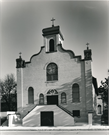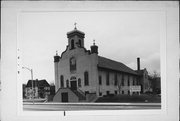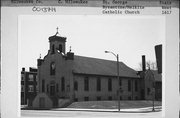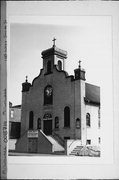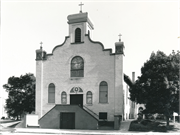| Additional Information: | A 'site file' exists for this property. It contains additional information such as correspondence, newspaper clippings, or historical information. It is a public record and may be viewed in person at the Wisconsin Historical Society, State Historic Preservation Office.
DESCRIPTION:
St. George's Melkite Catholic Church, built by H. Schmitt & Son in 1917, is a single-story, beige brick, gabled church that rests on an elevated baement level. Its simple planar north or main facade is reminiscent of Middle Eastern Byzanite architecture and features three bulbous domes. The largest dome tops the central tower and is flanked by two smaller ones at each gable end. The unornamented facade is punctuated by a central entrance flanked by arched sidelights and full height windows surmounted by a large arched window of leaded glass. The nave walls have six windows each. To the east and west of the church building are broad side yards with minimal landscaping. A 1925 addition to the church's south elevation is situated perpendicular to the nave. This addition includes the church offices, pastor's study lavatory and storage rooms.
Interiors were not visited.
ARCHITECTURAL/ENGINEERING SIGINIFICANCE:
Although primarily of historic significance, St. George's Melkite Catholic Church is the best example of Byzantine Revival inspired architecture in the city when compared to S.S. Cyril and Methodias Russian Orthodox Church, the other examples.
It also exemplifies the association between ethnicity and architectural design. Whereas Milwaukee's other ethnic groups, regardles of origin or creed, almost always select a version of either the Gothic Revival or of the Classical Revival for thier church buildings, the Melkites strove to reflect their near eastern origins in the design of their church. It is believed to be the only Byzantine Melkite parish in Wisconsin.
HISTORICAL BACKGROUND:
St. George's serves Milwaukee's Syrian-Lebanese community as a cultural as well as spiritual center. The first Syrian immigrants arrived in Milwaukee in 1895 and formed a community in the area bounded by Kilbourn, Highland, 6th and 20th Streets. Their background in the Eastern Church plus their unfamiliarity with English or Latin liturgy compelled them to form their own parish. In 1911 Archbishop Sebastian Messmer appointed the Reverend Timothy Jock to serve the congregation. The first services took place in a former dance hall at 627 West State Street. In 1915 the congregation purchased a house at 1615 West State Street and used it as a place of worship. On September 20, 1917, the cornerstone was laid for the present building, which was dedicated on December 23, 1917. The Milwaukee architecture firm of Erhard Brielmaier and Sons designed the present church. In 1925 the building was enlarged to its present size. It continues to house its original congregation which today numbers about 125 members. (C, D, E).
HISTORICAL SIGNIFICANCE:
Normally religious properties are excluded from listing in the National Register, but St. George Melkite Greek Catholic Church is of statewide historical significance because it was the first and remains the only surviving Melkite church in Wisconsin. It is an expression of a period in Wisconsin's history when numerous Lebanese immigrants settled in the state. One sizeable Syrian community formed in LaCrosse in the early years of this century and established a congregation in the 1920s. That congregation dissolved by the 1970s when its pastor was transferred to the East Coast and no further priests were sent from Syria. Wisconsin's only other Syrian-Lebanese colony formed in Milwaukee where a stong community developed that became the nucleus of St. George's. The Melkite Greek Catholic Church is an eastern sect of the Roman Catholic Church which derives its liturgical forms and authority from the Patriarch of Constantinople who currently resides in Damascus. (C).
Another map code is 21/23.
1925 addition to south end.
Simple brick gable-roof structure with facade designed in the mode of the Byzantine Church, with three bulbous domes. The largest dome tops the central tower, flanked by two smaller ones at each gable end. All of the stained glass in the round headed windows is original. The circular one in the main facade depicts the patron St. George. The choir loft and pews are also original to the building.
This is the only surviving Byzantine_Melkite church in Wisconsin. Rev. Ronald Golini, in his history of the congregation, states that "for many years, the church served as the cultural and spiritual nucleus of the Syrian-Lebanese community." In 1895, the first immigrants from Syria arrived in Milwaukee, settling in an area bordered by Kilbourn and Highland Avenues, and Sixteenth to Twentieth Streets. Their background in the Eastern Church, plus their unfamiliarity with English or Latin liturgy, compelled them to seek their own parish and priest. In 1911 Archbishop Sebasitan Messmer appointed Rev. Timothy Jock for the congregation. The first services took place in an unused dance hall at 627 W. State Street. In 1915 the congregation purchased a house at 1615 W. State Street, for a place of worship, which was later used as the rectory. On September 30, 1917, the cornerstone for the present building was laid, and the dedication took place on December 23, 1917.
Builder was H. Schmitt & Son.
"The church architecture of the middle eat was introduced to Milwaukee when Arabic-speaking Christians from Syria built St. George's church. It is a striking example of the association between ethnicity and architectural design and remains the city's only Middle-Eastern variation of the Byzantine style.
The ancient city of Byzantium, which as Constantinople became the capitol of the eastern Roman Empire and is today known as Istanbul, was the birthplace of Byzantine architecture around the sixth century. Regional variations of the style spread throughout Eastern Europe, the Middle East and Asia Minor. Hallmarks of the style include round-arched windows and the use of domed roofs. These domes eventually began to assume a variety of complex ornamental shapes that often reflected the ethnic origin of their builders.
The ethnic architecture of St. George's is embodied primarily in its three unusual domical metal roofs and the eye-catching scrolled curves on the front gable. The off-white brick walls are reminiscent of the light-colored stucco, dried brick, and stone structures that are common in the sunny, Asia Minor climate. The interior is finished with a segmental-arched plaster ceiling. The focal point of the interior is a splendid eastern style church fitting at the front of the church called an "iconostas" which is a half wall decorated with religious pictures called icons and it separates the worshipers from the altar area of the church.
Although it is a Roman Catholic parish, St. George's is unusual in that it maintains the ancient Syrian tradition of following the Melkite Rite, which is a form of worship that is similar to the one used by the Eastern Orthodox church. The parish was founded in 1911 by a group of Syrian and Syrian-Lebanese immigrants who began meeting in a rented hall at the southeast corner of North Seventh and West State Streets. The first Syrian immigrants began arriving in Milwaukee in the mid-1890s and by 1910 their numbers had grown to about 800. Most settled around West State Street between North Seventh and North Twentieth Streets. The parish is still Wisconsin's only Middle Eastern Melkite Rite Catholic Church." MILWAUKEE ETHNIC CHURCH TOUR, CITY OF MILWAUKEE DEPARTMENT OF CITY DEVELOPMENT, 1994. |
|---|
| Bibliographic References: | A. Milwaukee City Building Permits.
B. Cornerstone.
C. Golini, Rev. Ronald, Pastor St. George's Church. Paper sent to Milwaukee Landmarks Commission, April 1974. This paper recounts, in brief, the history of the Syrian-Lebanese in Milwaukee as it relates to the founding of St. George's Church. There is also a short description of how the Byzantine rite of the Catholic church differs from that of the western Roman Catholics.
D. Milienewicz, Rev. Frank, current pastor of St. George's Church. Telephone conversation between Rev. Milienewicz and Carlen Hatala, research consultant, Department of City Development, on the congregation's history, August 15, 1984. In this conversation, Rev. Milienewicz confirmed that St. George is the only Melkite congregation in the State of Wisconsin.
E. Rummel, Leo. "History of the Catholic Church in Wisconsin." Madison, Wisconsin, Wisconsin State Council, Knights of Columbus, 1976. Pp. 119.
PERRIN 1967, 125-126.
MILWAUKEE ETHNIC CHURCH TOUR, CITY OF MILWAUKEE DEPARTMENT OF CITY DEVELOPMENT, 1994.
BUILT IN MILWAUKEE, LANDSCAPE RESEARCH, P. 136.
Young, Places of Worship, 27. |
|---|

